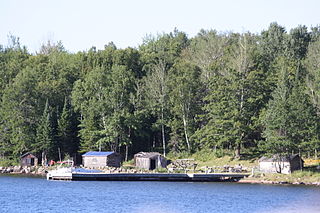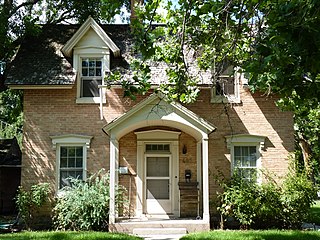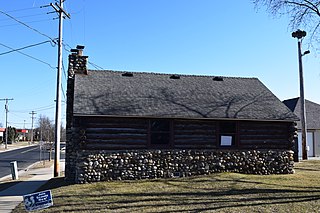
Abraham Lincoln Birthplace National Historical Park is a designated U.S. historic park preserving two separate farm sites in LaRue County, Kentucky, where Abraham Lincoln was born and lived early in his childhood. He was born at the Sinking Spring site south of Hodgenville and remained there until the family moved to the Knob Creek Farm northeast of Hodgenville when he was two years old, living there until he was seven years of age. The park's visitor center is located at the Sinking Spring site.

Manitou Camp is a logging and fishing camp started in the 1890s on Manitou Island, part of the Apostle Islands National Lakeshore. Today, as historically, Manitou Camp is used as a campground and as a facility for fishing. It has been listed on the National Register of Historic Places since 1983 and is owned by the National Park Service.

The John Patton Log Cabin is a log home located in Lexington Park District Park in Lexington, Illinois. The home was built in 1829 by John Patton, an early settler of McLean County. Patton, who was originally from Switzerland County, Indiana, came to a Kickapoo village in the area; he built his cabin with the tribe's assistance three months after his arrival. After McLean County was incorporated in 1831, the cabin became one of its first polling places. The cabin is now the only surviving early government building in the county as well as the only remnant of European interactions with Native Americans. The City of Lexington renovated the cabin in 1969 and now uses it as a museum.

Sequoyah's Cabin is a log cabin and historic site off Oklahoma State Highway 101 near Akins, Oklahoma. It was the home between 1829 and 1844 of the Cherokee Indian Sequoyah, who in 1821 created a written language for the Cherokee Nation. The cabin and surrounding park was declared a National Historic Landmark in 1965 and is now owned by the Cherokee Nation.

Copper Falls State Park is a 3,068-acre (1,242 ha) state park in Wisconsin. The park contains a section of the Bad River and its tributary the Tylers Forks, which flow through a gorge and drop over several waterfalls. Old Copper Culture Indians and later European settlers mined copper in the area. The state park was created in 1929 and amenities were developed by the Civilian Conservation Corps and the Works Progress Administration. In 2005 the park was listed on the National Register of Historic Places as a site with 10 contributing properties.

The Upper Granite Canyon Patrol Cabin was built by the Civilian Conservation Corps about 1935. The log structure is located in the extreme southwest backcountry of Grand Teton National Park. The cabin was built according to a standard design for such structures, in the National Park Service Rustic style. The Moran Bay Patrol Cabin is similar.

The Wonderland Trail is an approximately 93-mile (150 km) hiking trail that circumnavigates Mount Rainier in Mount Rainier National Park, Washington, United States. The trail goes over many ridges of Mount Rainier for a cumulative 22,000 feet (6,700 m) of elevation gain. The trail was built in 1915.

The Nisqually Entrance Historic District comprises the first public entrance to Mount Rainier National Park. The district incorporates the log entrance arch typical of all Mount Rainier entrances, a log frame ranger station and checking station, a comfort station and miscellaneous service structures, all built around 1926, as well as the 1915 Superintendent's Residence and the 1908 Oscar Brown Cabin, the oldest remaining structure in the park. The buildings in the district conform to the principles of the National Park Service Rustic style that prevailed in park design of the 1920s and 1930s.

The Hodgdon Homestead Cabin was built by Jeremiah Hodgdon in 1879 in the Aspen Valley area of what became Yosemite National Park. The two-story log cabin, measuring 22 feet (6.7 m) by 30 feet (9.1 m), was located in an inholding in the park, owned by Hodgdon's descendants. In the 1950s the family proposed to demolish the structure. The National Park Service acquired it and moved it to its Pioneer Yosemite History Center at Wawona, where the restored cabin is part of an exhibit on early settlement and development of the Yosemite area. In addition to housing Hogdon, the cabin housed workers on the Great Sierra Wagon Road in the 1880s, as a patrol cabin for U.S. Army troops who managed the new national park in the 1890s, and as a historic landmark at the old Aspen Valley Resort.

The Johnson–Hansen House is a historic house located in Provo, Utah, United States, that is listed on the National Register of Historic Places.

The Timberline Cabin in Rocky Mountain National Park, Colorado, USA was built in 1925 to house workers on the Fall River Road. The National Park Service rustic style cabin was designed by the National Park Service's Landscape Engineering Division under the direction of Thomas Chalmers Vint. The cabin was later used as a patrol cabin and as a caretaker's residence.

The Thunder Lake Patrol Cabin is a small structure in Rocky Mountain National Park, Colorado. Built in 1930, the 12-foot (3.7 m) by 16-foot (4.9 m) cabin may have been built as a simple shelter, but has more recently been used on an occasional basis as a backcountry patrol cabin in the Wild Basin area. The one story one-room log cabin is not used in the winter, but does have a stove with a stone fireplace. The main cabin is gable-roofed, with a small shed-roofed porch, and is a good example of the National Park Service rustic style. The logs are saddle-notched, projecting an increasing distance at their ends from top to bottom.

The Hadland Fishing Camp is a historic fishing camp in the Apostle Islands of Ashland County, Wisconsin. Built in 1938, the camp is located on the eastern shore of Rocky Island and is part of the Rocky Island Historic District. It was added to the National Register of Historic Places on August 18, 1977.

The Antigo Public Library and Deleglise Cabin comprise a historic site in Antigo, Wisconsin. The library building is a Carnegie library built in 1904. In 1997, the Antigo Public Library left the building; it is now a museum and the headquarters of the Langlade County Historical Society. The Deleglise Cabin, the first home in Antigo, was constructed by George Eckart in 1878 on the Springbrook and inhabited by Francis A. Deleglise. The cabin was moved near the library in 1916. Both buildings were added to the National Register of Historic Places on December 18, 1978.

The Saint Mary Ranger Station is a ranger station in Glacier National Park in the U.S. state of Montana. The log cabin was built in 1913 on the east side of the park overlooking Upper Saint Mary Lake. The oldest administrative structures in the park., it features an architecture that foreshadows the National Park Service Rustic style.

The Urjans Iverson House is a historic log cabin in Gilchrist Township, Minnesota, United States, built in 1866. It was restored in 1990 and is preserved within Fort Lake Johanna Roadside Park off Minnesota State Highway 104. The cabin was listed on the National Register of Historic Places in 1982 for its local significance in the theme of exploration/settlement. It was nominated for its broad associations with the early settlement of Pope County.

The Whaleback Snow-Survey Cabin, about 10 miles (16 km) north of Prospect in the Rogue River–Siskiyou National Forest in southwest Oregon, is a log cabin with a "snow tower" built in 1937. It is situated on the east slope of Whaleback Mountain. It was listed on the National Register of Historic Places in 2000.

The Aslak Lie Cabin in Springdale, Wisconsin was built in 1848 by a Norwegian immigrant master craftsman who mixed traditional techniques from the old country with newer American ways of building. The cabin was listed on the National Register of Historic Places in 1986 and on the State Register of Historic Places in 1989.

The Palmyra Boy Scout Cabin is a log cabin at 105 N. 1st Street in Palmyra, Wisconsin. Palmyra's Boy Scout Troop 14 built the cabin from 1935 to 1937. At the time, building a troop cabin was a popular activity for Boy Scouts and encouraged by the national organization; the Boy Scout Handbook included instructions on how to build a cabin, and Boys Life magazine featured completed cabins. Scouts and their fathers built the cabin; the Palmyra cabin took two years to complete on account of the Great Depression, which limited the troop's funds for building supplies, and many of the cabin's materials were donated. The one-room cabin measures 22 by 32 feet and uses saddle notch corners, which are designed to tighten over time as the building settles. The Boy Scouts have used the cabin continuously since it was built, and the cabin was renovated in the 2000s.
The Drohman Cabin is a one and a half story log cabin built about 1850 in Madison, Wisconsin, United States. The main structure was made of hand-hewn oak logs joined by German-style dovetail joints. Interior walls are wattle-and-daub, which is unusual in Wisconsin. It was listed on the National Register of Historic Places in 1981. In 1989, it was moved near the Wisconsin River and Helena, Wisconsin in Iowa County.





















